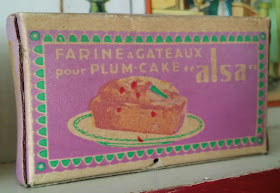If you've read my blog for awhile, you'll know that I have a thing for antique miniature dollhouse shops, particularly the little toy grocery stores that were made in Germany for many years. Here's something a little different: three miniature dollhouse stores that were made in France, circa the 1900s - early 1930s. This type of store was called an epicerie, the French term for a grocery store or delicatessen, and the style was very different from the German, being more of a flat counter than a three dimensional room box.
Along with the small German shop in the foreground, they all came from the collection of a woman whose mother had been the display designer for the toy department windows at the legendary John Wanamaker store in Philadelphia in the 1920s and 30s. These all featured in store window displays over the years, and later became playthings of the designer's family. They were lovingly cared for, and amazingly still retain most of their original items.
Let's go shopping! We'll start with my favorite, the art nouveau styled shop, which measures 19 inches tall and dates circa the early 1900s. It features lovely stenciled designs, a faux wood grained paper covered base, and loads of original accessories including plaster breads and cheeses, glass bottles, tin utensils, and wooden packages of fondant, biscuits, and other delicacies.
 |
| Tiny tin pans and scoops hang from a shelf. |
 |
| Look at the detail on the original shelf paper trim, and the label on the little can! |
 |
| These delicate glass bottles, incredibly, survived nearly 100 years of display and play. |
 |
| The shop came complete with a little dustpan and brush for cleaning up the day's crumbs. |
This beautiful store was the perfect destination for a French dolly who wanted some cheese and crackers, and maybe a little wine to go with them.
For a dolly that wanted to do some baking, this next shop might have been a better choice, as it features loads of tiny drawers that originally would have been filled with loose dry goods like sugar and flour for a child to scoop and measure out. This one dates circa the 1920s.
 |
| This little chocolate box has an illustration of French comic character Tintin on the side. |
This store came with beautiful glazed porcelain dishes holding plaster foods. They display nicely on the long counter that runs the width of the shop.
The last epicerie is very unusual, circa the early 1930s, and I thought it was actually homemade due to the handlettering on the drawers and the poorer quality of the painting. I've since seen another just like it but without the lithographed papers on the interior. My guess is it was made at home from a kit or plans in a magazine, which was a bit of a trend for dollhouses of this time period. The lithographed papers are what make this one special. They feature beautiful illustrations of much earlier times, showing Victorian era shoppers at their own grocery stores.
This shop appears to be the one the children of the window designer played with the most, as it came with added products from the 1940s and 50s.
The likely more original packages include a little can of tinned crab meat, triangular cheese boxes, and a plum pudding.
That's the end of our epicerie tour. I'll post the little German shop separately. Now I'm off to do my real life grocery shopping, which isn't nearly as fun as this was!


























